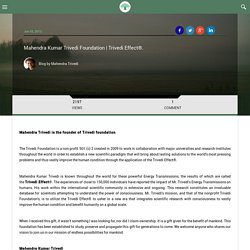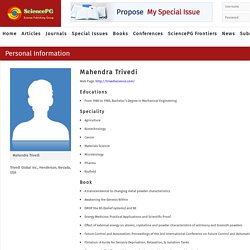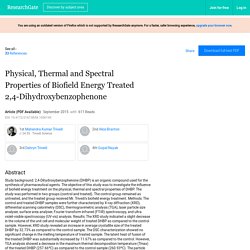

An Experimental Study on Plant Growth & Adaptation. Biofield Effect on Growth of Pogostemon cablin (Benth.) Mahendra Trivedi : Founder of The Trivedi Effect® Mahendra Trivedi and Trivedi Effect® Trivedi Effect : Human Wellness Programs. Trivedi Effect Podcast Available on CNET.com. Pros In this app the latest information and online video can be seen.

Cons Like the app as Trivedi Effect is something amazing for which i got curious to know and downloaded from Google Playstore Reply to this review Was this review helpful? Through this Trivedi Effect App, i was able to connect through Mahendra Trivedi and join his upgraded program. Since upgrading to the Daily Transmission Program, there is such a difference in growth in consciousness. The online webcast related to Trivedi Effect can be watched. The description on Google play store is about the Trivedi Effect. Good one, Easily get the latest information about The Trivedi Effect and all the online webcast can be watched. what benefits the user can take through this app should be described. The Trivedi Effect on CrunchBase. The Trivedi Effect® - Mahendra Trivedi- Slideshare.
Mahendra Trivedi : An Independent Researcher. Biofield Independent Researcher Henderson, NV, US Mahendra Kumar Trivedi earned his 5-year Bachelor’s degree in Mechanical Engineering in 1985 .

Mahendra Kumar Trivedi worked as an Engineer for 10 years. In 1995, Mr. Trivedi discovered that he had the unique ability to harness the energy from the universe and transmit it to anywhere on the globe, infusing it into living organisms and nonliving materials, thus optimizing their potential. Human Anatomy and Physiology. Mahendra Trivedi's Biofield Treatment on Pseudomonas fluorescens. Mahendra Trivedi - Biofield Energy Treatment & Researches. About Mahendra Trivedi earned his 5-year Bachelor’s degree in Mechanical Engineering in 1985 and worked as an Engineer for 10 years.

In 1995, Mr. Trivedi discovered that he had the unique ability to harness the energy from the universe and transmit it to anywhere on the globe, infusing it into living organisms and nonliving materials, thus optimizing their potential. For the next 5-7 years, Trivedi applied this newfound discovery to helping people optimize their potential, and this unique phenomenon resulting from Mr. Trivedi’s biofield energy treatments became internationally renowned as The Trivedi Effect®. Dr. Deepak Chopra Reviews about Mahendra Trivedi.
Mahendra Kumar Trivedi - Founder of Trivedi Foundation. Mahendra Trivedi is the founder of Trivedi foundation The Trivedi Foundation is a non-profit 501 (c) 3 created in 2009 to work in collaboration with major universities and research institutes throughout the world in order to establish a new scientific paradigm that will bring about lasting solutions to the world’s most pressing problems and thus vastly improve the human condition through the application of the Trivedi Effect®.

Mahendra Kumar Trivedi is known throughout the world for these powerful Energy Transmissions, the results of which are called the Trivedi Effect®. Mahendra Kumar Trivedi : Master of Energy Transformation. Mahendra Kumar Trivedi Biography. Mahendra Kumar Trivedi completed his Bachelor’s degree in Mechanical Engineering in 1985 and worked as an Engineer for 10 years.

In 1995, Mr. Trivedi discovered that he has the unique ability to harness the energy from the universe and transmit it to anywhere on earth, infusing it into living organisms and nonliving materials to optimize their potential. With this ability, Mr. Trivedi is a natural healer. He began healing people and optimizing their potential, and this extraordinary phenomenon became internationally renown as The Trivedi Effect®. Mahendra Kumar Trivedi's Google Scholar Citations. Dr. Rustum Roy Reviews about Mahendra Kumar Trivedi. Mahendra Kumar Trivedi : Science Publishing Group. Mahendra Trivedi Educations From 1980 to 1985, Bachelor’s Degree in Mechanical Engineering Speciality Agriculture.

Biofield Energy Treatment Influences on Soybean. Abstract: Soybean production in Iowa USA is among the most productive for rainfed regions in the world.

Despite generally having excellent soils, growing season temperatures and rainfall, soybean yields are decreased by weed interference and inadequate available soil water at key stages of crop development. A field study was conducted at two locations in Iowa in 2012 to determine if seed-applied fungicide or biofield treatments influenced weed community, soil volumetric water concentration and soybean yield and quality.
Properties of 2,4-Dihydroxybenzophenone. Study background: 2,4-Dihydroxybenzophenone (DHBP) is an organic compound used for the synthesis of pharmaceutical agents.

The objective of this study was to investigate the influence of biofield energy treatment on the physical, thermal and spectral properties of DHBP. The study was performed in two groups (control and treated). The control group remained as untreated, and the treated group received Mr. Trivedi’s biofield energy treatment. Methods: The control and treated DHBP samples were further characterized by X-ray diffraction (XRD), differential scanning calorimetry (DSC), thermogravimetric analysis (TGA), laser particle size analyser, surface area analyser, Fourier transform infrared (FT-IR) spectroscopy, and ultra violet-visible spectroscopy (UV-vis) analysis.
Effect on Spectral Properties of 2,4-Dihydroxybenzophenone. Description Study background: 2,4-Dihydroxybenzophenone (DHBP) is an organic compound used for the synthesis of pharmaceutical agents.

The objective of this study was to investigate the influence of biofield energy treatment on the physical, thermal and spectral properties of DHBP. The study was performed in two groups (control and treated). Biofield & its Effect on Dihydroxybenzophenone Compound. Biofield Treatment on Dihydroxybenzophenone Compound. Properties of Dihydroxybenzophenone organic compound. Spectral Properties of Biofield Treated 2,4-Dihydroxybenzophenone. Citation: Trivedi MK, Tallapragada RM, Branton A, Trivedi D, Nayak G, et al. (2015) Physical, Thermal and Spectral Properties of Bioeld Energy Treated 2,4-Dihydroxybenzophenone.

Clin Pharmacol Biopharm 4: 145. doi:10.4172/2167-065X.1000145 Page 8 of 8 Volume 4 • Issue 4 • 1000145 Clin Pharmacol Biopharm. Mahendra Trivedi Biofield Energy Treated Dihydroxybenzophenone. Biofield Treatment Effect on Stenotrophomonas maltophilia. Biofield and its Effect on 1,2,3-Trimethoxybenzene. Description Study background: 1,2,3-Trimethoxybenzene is an important compound used for the synthesis of chemicals and pharmaceutical agents. The objective of this study was to investigate the influence of biofield energy treatment on the physical, thermal and spectral properties of 1,2,3-trimethoxybenzene. Methods: The study was performed by dividing the sample into two groups (control and treated).
The control group remained as untreated, while the treated group received Mr Trivedi’s biofield energy treatment. Biofield – Impact on Spectral Properties of 1,2,3-Trimethoxybenzene. Biofield Treated 1,2,3-Trimethoxybenzene Organic Compound. Spectral Properties of Biofield Treated 1,2,3-Trimethoxybenzene. Biofield Energy Treated 1,2,3-Trimethoxybenzene. Citation: Trivedi MK, Tallapragada RM, Branton A, Trivedi D, Nayak G, et al. (2015) Physical, Thermal and Spectral Properties of Bioeld Treated 1,2,3-Trimethoxybenzene. J Develop Drugs 4: 136. doi:10.4172/2329-6631.1000136 Page 7 of 8 Volume 4 • Issue 4 • 1000135 J Develop Drugs ISSN: 2329-6631 JDD an open access journal peaks as compared to the control. Treatment may not aect the energy gap of highest occupied molecular orbital and lowest unoccupied molecular orbital (HOMO–LUMO gap).
An Open Access Journal of Developing Drugs. Abstract Study background: 1,2,3-Trimethoxybenzene is an important compound used for the synthesis of chemicals and pharmaceutical agents. The objective of this study was to investigate the influence of biofield energy treatment on the physical, thermal and spectral properties of 1,2,3-trimethoxybenzene. Methods: The study was performed by dividing the sample into two groups (control and treated). The control group remained as untreated, while the treated group received Mr Trivedi’s biofield energy treatment.
Dose and Distance in a Model of Cancer Cell Death. Effect of Biofield on Spectral Properties of p-Nitroaniline. Description Para nitroaniline (p-Nitroaniline) is an organic compound, used as an intermediate in the synthesis of pharmaceuticals drugs, gasoline and dyes. The present study was attempted to investigate the influence of biofield treatment on p-nitroaniline. The study was performed in two groups i.e., control and treatment. An impact of Biofield Treatment on Para nitroaniline – Read more. Spectral Properties of p-Nitroaniline – Aftermath. Impact of Biofield Treatment on p-Nitroaniline Properties. Properties of p-Nitroaniline after Biofield Treatment. An Open Access Research Article on Pharmaceutical Compounds. Effect of Biofield Treatment on Paracetamol and Piroxicam. Impact on Barium Titanate Powder. Abstract Barium titanate, perovskite structure is known for its high dielectric constant and piezoelectric properties, which makes it interesting material for fabricating capacitors, transducer, actuator, and sensors.
The perovskite crystal structure and lattice vibrations play a crucial role in its piezoelectric and ferroelectric behavior. In the present study, the barium titanate powder was subjected to biofield treatment. Further, the control and treated samples were characterized using X-ray diffraction (XRD) and Fourier transform infrared spectrometer (FT-IR) and Electron spin resonance (ESR). The XRD analysis showed the permanent compressive strain of 0.45% in treated barium titanate powder as compared to control. Keywords: Biofield treatment; Barium titanate; Fourier transform infrared; X-Ray diffraction; Electron spin resonance Introduction.
The Trivedi Effect® Impact on Antimony Sulfide – Study more. Abstract Antimony sulfide (Sb2S3) has gained extensive attention in solar cells due to their potential as a low-cost and earth abundant absorber material. In solar cell absorber, the optoelectrical properties such as energy band gap and absorption coefficient of Sb2S3 play an important role, which have strong relationships with their crystal structure, lattice parameter and crystallite size. Hence in the present investigation, Sb2S3 powder samples were exposed to biofield treatment, and further its physical, structural and spectral properties are investigated. The particle size analysis showed larger particle size and surface area after treatment. X-ray diffraction (XRD) analysis revealed polycrystalline orthorhombic structure with superior crystallinity in treated Sb2S3 along with significant changes in the lattice parameters, which led to changes in unit cell volume and density. Introduction Experimental Particle size analysis Surface area analysis.
Properties of Ceramic Oxide Nano Powders. Abstract Transition metal oxides (TMOs) have been known for their extraordinary electrical and magnetic properties. In the present study, some transition metal oxides (Zinc oxide, iron oxide and copper oxide) which are widely used in the fabrication of electronic devices were selected and subjected to biofield treatment. Biofield Effect on Carbon Allotrope Powders. Trivedi Effect on Characteristics of Pharmaceutical Compounds. Effect on Growth or Yield of Lettuce & Tomato. Abstract: Recent studies report the effect of biofield treatment on changes in structural characteristics of organic and inorganic matter, on cancer cells in vitro and on overall plant development.
This study tested the impact of the same treatment applied to lettuce and tomato seeds and transplants (Lactuca sativa var. capitata and Lycopersiconesculentum var. Roma) in commercial plantings with and without fertilizers and pesticides, in relation to yield, quality, and pest inhibition. Treated lettuce plants with fertilizer and pesticide applications were more vigorous, exhibited less incidence of soil-borne fungal wilt, and subsequent yield was statistically greater 43% compared to untreated plants. Treated plants with no fertilizer or pesticide applications in the field behaved similarly to untreated plants that received routine fertilizer and pest control inputs. Keywords: Crop development; Biofield treatment; Fertilizer and Organic; Lettuce; Tomato.
Biofield Energy Influence on Soybean Productivity. Abstract.